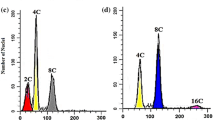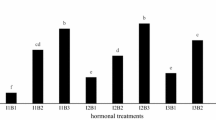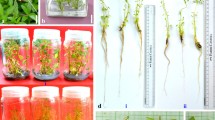Abstract
In this study, the effects of ploidy level and culture medium were studied on the production of tropane alkaloids. We have successfully produced stable tetraploid hairy root lines of Hyoscyamus muticus and their ploidy stability was confirmed 30 months after transformation. Tetraploidy affected the growth rate and alkaloid accumulation in plants and transformed root cultures of Egyptian henbane. Although tetraploid plants could produce 200% higher scopolamine than their diploid counterparts, this result was not observed for corresponding induced hairy root cultures. Culture conditions did not only play an important role for biomass production, but also significantly affected tropane alkaloid accumulation in hairy root cultures. In spite of its lower biomass production, tetraploid clone could produce more scopolamine than the diploid counterpart under similar growth conditions. The highest yields of scopolamine (13.87 mg l−1) and hyoscyamine (107.7 mg 1−1) were obtained when diploid clones were grown on medium consisting of either Murashige and Skoog with 60 g/l sucrose or Gamborg’s B5 with 40 g/l sucrose, respectively. Although the hyoscyamine is the main alkaloid in the H. muticus plants, manipulation of ploidy level and culture conditions successfully changed the scopolamine/hyoscyamine ratio towards scopolamine. The fact that hyoscyamine is converted to scopolamine is very important due to the higher market value of scopolamine.






Similar content being viewed by others
References
Baíza AM, Quiroz-Moreno A, Ruíz JA, Loyola-Vargas VA (1999) Genetic stability of hairy root cultures of Datura stramonium. Plant Cell Tiss Organ Cult 59:9–17. doi:10.1023/A:1006398727508
Berkov S, Philipov S (2002) Alkaloid production in diploid and autotetraploid plants of Datura stramonium. Pharm Biol 40(8):617–621
Berkov S, Pavlov A, Kovatcheva P, Stanimirova P, Philipov S (2003) Alkaloid spectrum in diploid and tetraploid hairy root cultures of Datura stramonium. Z Naturforsch 58c:42–46
Cebolla A, Vinardell JM, Kiss E, Olah B, Roudier F, Kondorosi A, Kondorosi E (1999) The mitotic inhibitor ccs52 is required for endoreduplication and ploidy dependent cell enlargement in plants. EMBO J 18:4476–4487. doi:10.1093/emboj/18.16.4476
Christen P, Aoki T, Shimomura K (1992) Characteristics of growth and tropane alkaloid production in Hyoscyomus albus hairy roots transformed with Agrobacterium rhizogenes A4. Plant Cell Rep 11:597–600. doi:10.1007/BF0023638011:59600
De Jesus-Gonzalez L, Weathers PJ (2003) Tetraploid Atemisia annua hairy roots produce more artemisinin than diploids. Plant Cell Rep 21:809–813. doi:10.1007/s00299-003-0587-8
Dhawn OP, Lavania UC (1996) Enhancing the productivity of secondary metabolites via induced polyploidy: a review. Euphytica 87:81–89. doi:10.1007/BF00021879
Dolezel J, Binarova P, Lucretti S (1989) Analysis of nuclear DNA content in plant cells by flow cytometry. Biol Plant 31:113–120. doi:10.1007/BF02907241
Gamborg OL, Miller RA, Ojima K (1968) Nutrient requirement of suspension cultures of soybean root cells. Exp Cell Res 50:151–158
Georgiev MI, Pavlov A, Bley T (2007) Hairy root type plant in vitro systems as sources of bioactive substances. Appl Microbiol Biotechnol 74:1175–1185. doi:10.1007/s00253-007-0856-5
Häkkinen ST, Moyano E, Cusido RM, Palazon J, Pinol MT, Oksman-Caldentey KM (2005) Enhanced secretion of tropane alkaloids in Nicotiana tabacum hairy roots expressing heterologous hyoscyamine-6β-hydroxylase. J Exp Bot 420:2611–2618. doi:10.1093/jxb/eri253
Hashimoto T, Yun DJ, Yamada Y (1993) Production of tropane alkaloids in genetically engineered root cultures. Phytochemistry 32:713–718. doi:10.1016/S0031-9422(00)95159-8
Huang F, Dai XD, Hu YL, Chen CY, Zhu GZ (2005) Progress in synthesis of tropane alkaloids. Chem Reag 27:141–144. doi:cnki:ISSN:0258-3283.0.2005-03-004
Jouhikainen K, Lindgren L, Jokelainen T, Hiltunen RH, Teeri T, Oksman-Caldentey KM (1999) Enhancement of scopolamine production in Hyoscyamus muticus L. hairy root cultures by genetic engineering. Planta 208:545–551. doi:10.1007/s004250050592
Kaensaksiri T, Soontornchainaksaeng P, Soonthornchareonnon N, Prathanturarug S (2011) In vitro induction of polyploidy in Centella asiatica (L.) Urban. Plant Cell Tiss Organ Cult 107:187–194. doi:10.1007/s11240-011-9969-8
Kai G, Chen J, Li L, Zhou G, Zhou L, Zhang L, Chen Y, Zhao L (2007) Molecular cloning and characterization of a new cDNA encoding hyoscyamine 6β-hydroxylase from roots of Anisodus acutangulus. J Biochem Mol Biol 40:715–722
Lavania UC (1986) Genetic improvement of Egyptian henbane, Hyoscyamus muticus L. through induced tetraploidy. Theor Appl Genet 73:292–298. doi:10.1007/BF00289288
Lavania UC (2005) Genomic and ploidy manipulation for enhanced production of phyto-pharmaceuticals. Plant Genet Resour 3:170–177. doi:10.1079/PGR200576
Lavania UC, Srivastava S (1988) Ploidy dependence of chromosomal variation in callus cultures of Hyoscyamus muticus L. Protoplasma 145:55–58. doi:10.1007/BF01323256
Lema-Rumin’ska J (2011) Flow cytometric analysis of somatic embryos, shoots, and calli of the cactus Copiapoa tenuissima Ritt. forma monstruosa. Plant Cell Tiss Organ Cult 106:531–535. doi: 10.1007/s11240-011-9941-7
Lin X, Zhou Y, Zhang J, Lu X, Zhang F, Shen Q, Wu S, Chen Y, Wang T, Tang K (2011) Enhancement of artemisinin content in tetraploid Artemisia annua plants by modulating the expression of genes in artemisinin biosynthetic pathway. Biotechnol Appl Biochem 58:50–57. doi:10.1002/bab.13
Mateus L, Chekaoui S, Christen P, Oksman-Caldentey KM (2000) Simultaneous determination of scopolamine, hyoscyamine and littorine in plants and different hairy root clones of Hyoscyamus muticus by micellar electrokinetic chromatography. Phytochemistry 54:517–523. doi:10.1016/S0031-9422(00)00134-5
Obae SG, West TP (2010) Nuclear DNA content of Hydrastis canadensis L. and genome size stability of in vitro regenerated plantlets. Plant Cell Tiss Organ Cult 102:259–263. doi:10.1007/s11240-010-9719-3
Ochatt SJ, Patat-Ochatt EM, Moessner A (2011) Ploidy level determination within the context of in vitro breeding. Plant Cell Tiss Organ Cult 104:329–341. doi:10.1007/s11240-011-9918-6
Oksman-Caldentey KM (1986) Production of scopolamine and hyoscyamine in some solanaceous plants and cell cultures. Acta Pharm Fenn 95:49–58
Oksman-Caldentey KM, Arroo R (2000) Regulation of tropane alkaloid metabolism in plants and plant cell cultures. In: Verpoorte R, Alfermann AW (eds) Metabolic engineering of plant secondary metabolism, Kluwer, Dortrecht, pp 253–281. ISBN: 978-0-7923-6360-6
Oksman-Caldentey KM, Sevón N, Vanhala L, Hiltunen R (1994) Effect of nitrogen and sucrose on the primary and secondary metabolism of transformed root cultures of Hyoscyamus muticus. Plant Cell Tiss Organ Cult 38:263–272. doi:10.1007/BF00033886
Pavlov A, Berkov S, Weber J, Bley TH (2009) Hyoscyamine biosynthesis in Datura stramonium hairy root in vitro systems with different ploidy levels. Appl Biochem Biotechnol 157(2):210–225. doi:10.1007/s12010-008-8264-6
Pinto DLP, Barros BA, Viccini LF, Campos JMS, Silva ML, Otoni WC (2010) Ploidy stability of somatic embryogenesis-derived Passiflora cincinnata Mast. plants as assessed by flow cytometry. Plant Cell Tiss Organ Cult 103:71–79. doi:10.1007/s11240-010-9756-y
Rothe G, Drager B (2002) Tropane alkaloids- metabolic response to carbohydrate signal in root cultures of Atropa belladonna. Plant Sci 163:979–985. doi:10.1016/S0168-9452(02)00247-9
Saghai–Maroof MA, Soliman KM, Gorgensen RA, Allard RW (1984) DNA spacer length polymorphism in Barley: mendelian inheritance, chromosomal location and population genetics. Proc Natl Acad Sci USA 81:8014–8018
Sevón N, Oksman-Caldentey KM (2002) Agrobacterium rhizogenes-mediated transformation: root cultures as a source of alkaloids. Planta Med 68(10):859–868. doi:10.1055/s-2002-34924
Sevón N, Biondi S, Bagni N, Oksman-Caldentey KM (2001) Transgenic Hyoscyamus muticus. In: Bajaj YPS (ed) Biotechnology in agriculture and forestry. Springer, Berlin, pp 171–200
Shahriari F, Dehghan E, Farsi M (2009) Tetraploid induction of Hyoscyamus muticus L. using colchicine treatment. In: Proceedings of the 14th Austalasian plant breeding, 11th SABRAO conference, Australia
Stancheva N, Weber J, Schulze J, Alipieva K, Ludwig-Muller J, Haas C, Georgiev V, Bley T, Georgiev M (2011) Phytochemical and flow cytometric analyses of Devil’s claw cell cultures. Plant Cell Tiss Organ Cult 105:79–84. doi:10.1007/s11240-010-9844-z
Sun Q, Sun H, Bell RL, Li H, Xin L (2011) Variation of phenotype, ploidy level, and organogenic potential of in vitro regenerated polyploids of Pyrus communis. Plant Cell Tiss Organ Cult 107:131–140. doi:10.1007/s11240-011-9965-z
Weber J, Georgiev V, Pavlov A, Bley T (2008) Flow cytometric investigations of diploid and tetraploid plants and in vitro cultures of Datura Srtramonium and Hyoscyamus niger. Cytometry A 73:931–939. doi:10.1002/cyto.a.20628
Yang X, Ye CY, Cheng ZM, Tschaplinski TJ, Wullschleger SD, Yin W, Xia X, Tuskan GA (2011) Genomic aspects of research involving polyploid plants. Plant Cell Tiss Organ Cult 104:387–397. doi:10.1007/s11240-010-9826-1
Zolala J, Farsi M, Gordan HR, Mahmoodnia M (2007) Production a high scopolamine hairy root clone in Hyoscyamus muticus through transformation by Agrobacterium rhizogenes. J Agric Sci Technol 9:327–339
Acknowledgments
The authors wish to thank Professor G. Asghari (Department of Pharmacognosy, School of Pharmacy, Isfahan University of Medical Sciences) and Dr M. Zare for assistance in flow cytometry experiments. The authors also appreciate the Deputy of Research Affairs in Ferdowsi University of Mashhad for their financial supports provided as Grant No P446.
Author information
Authors and Affiliations
Corresponding author
Rights and permissions
About this article
Cite this article
Dehghan, E., Häkkinen, S.T., Oksman-Caldentey, KM. et al. Production of tropane alkaloids in diploid and tetraploid plants and in vitro hairy root cultures of Egyptian henbane (Hyoscyamus muticus L.). Plant Cell Tiss Organ Cult 110, 35–44 (2012). https://doi.org/10.1007/s11240-012-0127-8
Received:
Accepted:
Published:
Issue Date:
DOI: https://doi.org/10.1007/s11240-012-0127-8




